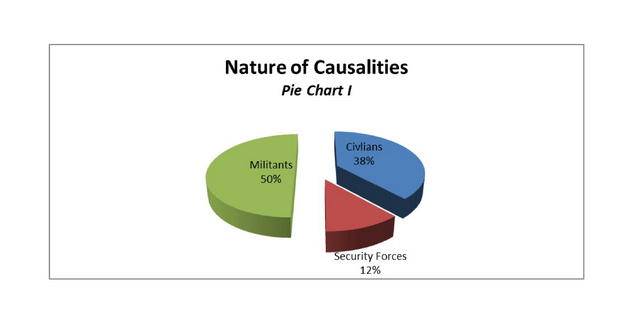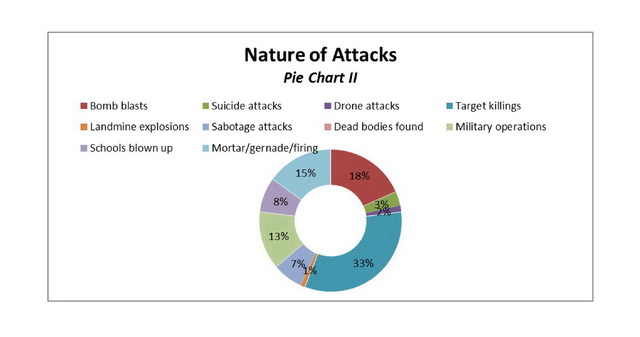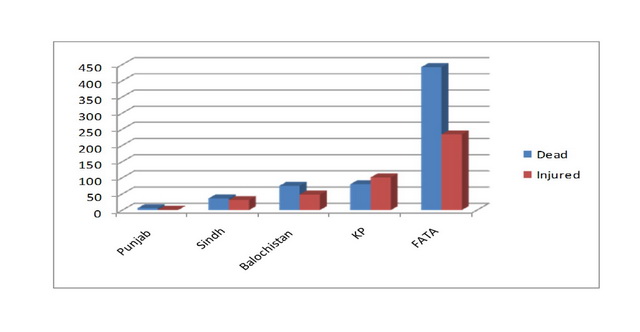Security landscape in Pakistan continued to embroil with persistent incidents of violence during March. Federally Administered Tribal Areas (FATA) and Khyber Pakhtunkhwa (KP) regions, the epicenter of fight against terrorism, witnessed major proportion of overall violence in the country. Adding to that, towards the end of the reported month, recurrent ethno-political violence engulfed the biggest city of Pakistan, Karachi, and brought the economic nerve of the country to standstill. The data collected through different sources suggested that 639 people lost their lives in 218 incidents of violence across the country (for details see data sheet). The violent clashes also left 371 people injured across the country.
 A trail through the data underscores that frequent clashes between militants and security forces, immersed in a violent campaign in FATA and KP regions resulted into the major loss of lives. As noted in pie chart I, militants accounted for almost 50 percent of the total deaths. The second highest number of casualties was of civilians, accounting for 38 percent of the total number. While 12 percent causalities were of security forces and those were mostly recorded in aforementioned insurgency infested areas. Meanwhile, it was noted that a whopping 88 percent of total causalities were of militants and civilians. Furthermore during the current month, three CIA operated drone strikes were also reported in different parts of North or South Waziristan Agency (FATA), resulting in the killing of 33 suspected militants and injuring seven others. During their malicious sabotage campaign to dismantle the state infrastructure, militants blew up 17 schools in different parts of FATA and KP during the course of month. Also, 15 sabotage attacks were reported in parts of Balochistan and Karachi, where miscreants blew up gas pipelines and torched vehicles.
A trail through the data underscores that frequent clashes between militants and security forces, immersed in a violent campaign in FATA and KP regions resulted into the major loss of lives. As noted in pie chart I, militants accounted for almost 50 percent of the total deaths. The second highest number of casualties was of civilians, accounting for 38 percent of the total number. While 12 percent causalities were of security forces and those were mostly recorded in aforementioned insurgency infested areas. Meanwhile, it was noted that a whopping 88 percent of total causalities were of militants and civilians. Furthermore during the current month, three CIA operated drone strikes were also reported in different parts of North or South Waziristan Agency (FATA), resulting in the killing of 33 suspected militants and injuring seven others. During their malicious sabotage campaign to dismantle the state infrastructure, militants blew up 17 schools in different parts of FATA and KP during the course of month. Also, 15 sabotage attacks were reported in parts of Balochistan and Karachi, where miscreants blew up gas pipelines and torched vehicles.
A concise look into the instruments of violence suggests that target killing was the major weapon for the violent actors, as pie chart II shows that 33 percent of the total attacks were related to target killings, and 127 people including 90 civilians perished as a result of that. Likewise bomb blasts were second major tool for the miscreants, making up 18% of the total attacks. Among bomb blasts, improvised explosive devices (IEDs) and road side bombs killed most of the victims. Military operations and incidents of mortar attacks and firing were also among the major forms of attacks during the month. Analysing the military operations, one finds that 29 clashes between the military and the militants, in different parts of the country, resulted in deaths of 273 persons, including 244 militants. Likewise, seven suicide (three percent of total incidents) attacks killed 59 people, including 44 civilians in different parts of the country, mostly in KP and FATA.
Moreover, scaling through the ferocity of violence in different areas of the country, one finds that militancy stricken areas of FATA bore the brunt of violence during the month of March. The bar chart below underlines that almost 442 people were killed in the said region in different circumstances and it accounted for 69 percent of the total killings across the country. Meanwhile, 80 people died in KP and 75 in Balochistan, which is almost 24 percent of the total causalities. Also, towards the end of March, the vicious cycle of ethno-political violence revisited Karachi and once again destabilized the security situation. The chart shows that 36 people were killed in Sindh and almost all of them fell prey to the ethno-political violence in Karachi, which ensued after the killing of two members of Mutihda Qaumi Movement (MQM)..
Furthermore, Shia minority in Pakistan continued suffered at the hands of sectarian terrorism during the current month. Whereby 10 Shia Muslims were killed as a result of target killings and bomb blasts allegedly by the majority Sunni extremist organizations. Hazara community (Shia) of Quetta, Balochistan, was once again targeted in a bomb blast and lost five persons, while five Shias were killed in tribal region (of Parachinar) and Karachi.
Thus, one finds that every form of violence from ethno-political to religio-political and nationalistic separatist is haunting the Pakistan and undermining the state security. Though security forces are trying their best to quell the raging violence, yet their efforts are falling short given the fact of ubiquitous violence and murkier nature of actors involved. A prudent analysis of violence suggests that political intervention coupled with strong will is the missing link in the fight against militancy and it cannot be bridged by the sophistication and professionalism of security forces.
Sources
- The News
- Dawn
- The Express Tribune
- Pakistan Today
- Daily Times
- Dateline Islamabad
- The Frontier Post
- Jang (Urdu)
- Daily Mashriq (Urdu)
- Aaj (Urdu)



